Studies on Xenopus laevis intestine reveal biological pathways underlying vertebrate gut adaptation from embryo to adult
- PMID: 20482879
- PMCID: PMC2898076
- DOI: 10.1186/gb-2010-11-5-r55
Studies on Xenopus laevis intestine reveal biological pathways underlying vertebrate gut adaptation from embryo to adult
Abstract
Background: To adapt to its changing dietary environment, the digestive tract is extensively remodeled from the embryo to the adult during vertebrate development. Xenopus laevis metamorphosis is an excellent model system for studying mammalian gastrointestinal development and is used to determine the genes and signaling programs essential for intestinal development and maturation.
Results: The metamorphosing intestine can be divided into four distinct developmental time points and these were analyzed with X. laevis microarrays. Due to the high level of conservation in developmental signaling programs and homology to mammalian genes, annotations and bioinformatics analysis were based on human orthologs. Clustering of the expression patterns revealed co-expressed genes involved in essential cell processes such as apoptosis and proliferation. The two largest clusters of genes have expression peaks and troughs at the climax of metamorphosis, respectively. Novel conserved gene ontology categories regulated during this period include transcriptional activity, signal transduction, and metabolic processes. Additionally, we identified larval/embryo- and adult-specific genes. Detailed analysis revealed 17 larval specific genes that may represent molecular markers for human colonic cancers, while many adult specific genes are associated with dietary enzymes.
Conclusions: This global developmental expression study provides the first detailed molecular description of intestinal remodeling and maturation during postembryonic development, which should help improve our understanding of intestinal organogenesis and human diseases. This study significantly contributes towards our understanding of the dynamics of molecular regulation during development and tissue renewal, which is important for future basic and clinical research and for medicinal applications.
Figures
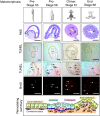
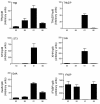


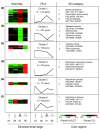
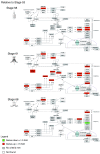
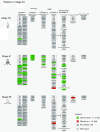
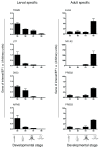
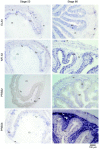
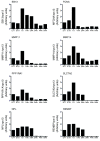
Similar articles
-
Pairing morphology with gene expression in thyroid hormone-induced intestinal remodeling and identification of a core set of TH-induced genes across tadpole tissues.Dev Biol. 2007 Mar 15;303(2):576-90. doi: 10.1016/j.ydbio.2006.11.037. Epub 2006 Dec 1. Dev Biol. 2007. PMID: 17214978
-
Thyroid Hormone-Induced Activation of Notch Signaling is Required for Adult Intestinal Stem Cell Development During Xenopus Laevis Metamorphosis.Stem Cells. 2017 Apr;35(4):1028-1039. doi: 10.1002/stem.2544. Epub 2016 Nov 25. Stem Cells. 2017. PMID: 27870267 Free PMC article.
-
Temporal and spatial expression of an intestinal Na+/PO4 3- cotransporter correlates with epithelial transformation during thyroid hormone-dependent frog metamorphosis.Dev Genet. 1997;20(1):53-66. doi: 10.1002/(SICI)1520-6408(1997)20:1<53::AID-DVG7>3.0.CO;2-8. Dev Genet. 1997. PMID: 9094212
-
How thyroid hormone regulates transformation of larval epithelial cells into adult stem cells in the amphibian intestine.Mol Cell Endocrinol. 2017 Dec 25;459:98-103. doi: 10.1016/j.mce.2017.02.026. Epub 2017 Feb 20. Mol Cell Endocrinol. 2017. PMID: 28232053 Review.
-
Dual functions of thyroid hormone receptors during Xenopus development.Comp Biochem Physiol B Biochem Mol Biol. 2000 Jun;126(2):199-211. doi: 10.1016/s0305-0491(00)00198-x. Comp Biochem Physiol B Biochem Mol Biol. 2000. PMID: 10874167 Review.
Cited by
-
Epithelial-connective tissue interactions induced by thyroid hormone receptor are essential for adult stem cell development in the Xenopus laevis intestine.Stem Cells. 2011 Jan;29(1):154-61. doi: 10.1002/stem.560. Stem Cells. 2011. PMID: 21280164 Free PMC article.
-
Intestinal remodeling during Xenopus metamorphosis as a model for studying thyroid hormone signaling and adult organogenesis.Mol Cell Endocrinol. 2024 May 15;586:112193. doi: 10.1016/j.mce.2024.112193. Epub 2024 Feb 22. Mol Cell Endocrinol. 2024. PMID: 38401883 Free PMC article.
-
Expression profiling of intestinal tissues implicates tissue-specific genes and pathways essential for thyroid hormone-induced adult stem cell development.Endocrinology. 2013 Nov;154(11):4396-407. doi: 10.1210/en.2013-1432. Epub 2013 Aug 22. Endocrinology. 2013. PMID: 23970787 Free PMC article.
-
Genome-wide identification of thyroid hormone receptor targets in the remodeling intestine during Xenopus tropicalis metamorphosis.Sci Rep. 2017 Jul 25;7(1):6414. doi: 10.1038/s41598-017-06679-x. Sci Rep. 2017. PMID: 28743885 Free PMC article.
-
Thyroid hormone regulation of adult intestinal stem cell development: mechanisms and evolutionary conservations.Int J Biol Sci. 2012;8(8):1217-24. doi: 10.7150/ijbs.5109. Epub 2012 Oct 23. Int J Biol Sci. 2012. PMID: 23136549 Free PMC article. Review.
References
-
- Dauca M, Bouziges F, Colin S, Kedinger M, Keller MK, Schilt J, Simon-Assmann P, Haffen K. Development of the vertebrate small intestine and mechanisms of cell differentiation. Int J Dev Biol. 1990;34:205–218. - PubMed
-
- Segal GH, Petras RE. In: Histology for Pathologists. Sternberg SS, editor. New York.: Raven Press, Ltd; 1992. Small intestine; pp. 547–571.
Publication types
MeSH terms
Substances
Grants and funding
LinkOut - more resources
Full Text Sources
Medical
Molecular Biology Databases

